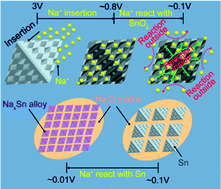Octahedral tin dioxidenanocrystals as high capacity anode materials for Na-ion batteries†
Abstract
Single crystalline SnO2

* Corresponding authors
a
Centre for Clean Energy Technology, School of Chemistry and Forensic Science, Faculty of Science, University of Technology, Sydney, Australia
E-mail:
Guoxiu.Wang@uts.edu.au
Fax: +61 2 9514 1460
Tel: +61 2 9514 1741
b College of Chemistry and Chemical Engineering, Yangzhou University, 180 Si-Wang-Ting Road, Yangzhou 225002, China
c School of Materials Science and Engineering, Gyeongsang National University, Jinju, Gyeongnam 660-701, Republic of Korea
Single crystalline SnO2

 Please wait while we load your content...
Something went wrong. Try again?
Please wait while we load your content...
Something went wrong. Try again?
D. Su, C. Wang, H. Ahn and G. Wang, Phys. Chem. Chem. Phys., 2013, 15, 12543 DOI: 10.1039/C3CP52037D
To request permission to reproduce material from this article, please go to the Copyright Clearance Center request page.
If you are an author contributing to an RSC publication, you do not need to request permission provided correct acknowledgement is given.
If you are the author of this article, you do not need to request permission to reproduce figures and diagrams provided correct acknowledgement is given. If you want to reproduce the whole article in a third-party publication (excluding your thesis/dissertation for which permission is not required) please go to the Copyright Clearance Center request page.
Read more about how to correctly acknowledge RSC content.
 Fetching data from CrossRef.
Fetching data from CrossRef.
This may take some time to load.
Loading related content
